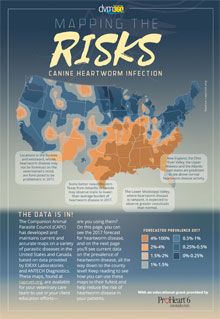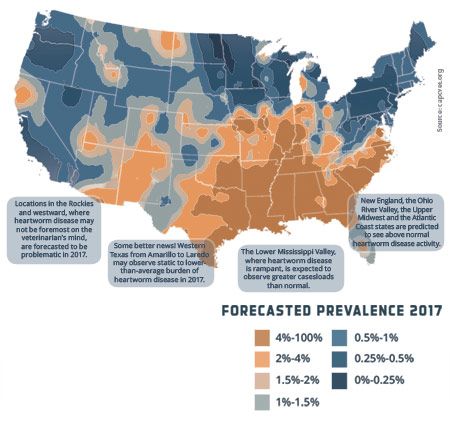Mapping the risks: Canine heartworm infection
Up-to-date CAPC maps can help your veterinary care team in your client education efforts on heartwormare you using them?

Click here for a clickable, printer-friendly version of this article.The data is in!
The Companion Animal Parasite Council (CAPC) has developed and maintains current and accurate maps on a variety of parasitic diseases in the United States and Canada, based on data provided by IDEXX Laboratories and ANTECH Diagnostics. These maps, found at capcvet.org, are available for your veterinary care team to use in your client education efforts-are you using them? Just below, you can see the 2017 forecast for heartworm disease, and below that you'll see current data on the prevalence of heartworm disease, all the way down to the county level! Keep reading to see how you can use these maps to their fullest and help reduce the risk of heartworm disease in your patients.


What's YOUR patients' risk of heartworm disease today?
Go to capcvet.org to find out what the parasite risks are in your area, and select the parasite you want to track (in this case, heartworm). First you'll see the total number of heartworm-positive test results veterinarians have reported in the entire United States and the total number of tests conducted. Then click on your state. You'll see the totals there as well. Then click on your county-you'll see how many dogs and cats have tested positive in your immediate region. Here we're showing the data for Rapides County, Louisiana, part of the heartworm hot zone that is the Mississippi Delta. If you sign up for updates at capcvet.org, you'll get new numbers on a regular basis sent right to your email. Nine out of 10 veterinary clients say they want this info!

Use an old-school whiteboard
to inform pet owners of local risks

Write your county's heartworm prevalence data on a whiteboard for clients to see.A simple dry erase whiteboard can change the conversation about parasite prevention from selling product to protecting patients. A 2015 study by the Companion Animal Parasite Council (CAPC) has shown that 90% of pet owners want their veterinarian to provide them with information on parasites. Posting local, timely parasite prevalence numbers in your waiting area can help stimulate conversation with your clients and provide a public service.
Step 1: Buy a whiteboard at an office supply store.
Step 2: Visit capcvet.org and click on “Parasite Prevalence Maps.”
Step 3: Identify the disease you want to highlight (such as heartworm infection) and find the prevalence data for your state and county.
Step 4: Write the number of cases in your county on the whiteboard and set it out or hang it near where clients check in and out.
Step 5: Educate clients about heartworm disease when they ask about the numbers on the board.
Step 6: Change the statistics you highlight on the board according to new data and changing seasonal risks (sign
up to receive updates at capcvet.org).
Want to hear more? Check out the video at dvm360.com/CAPCwhiteboard.

